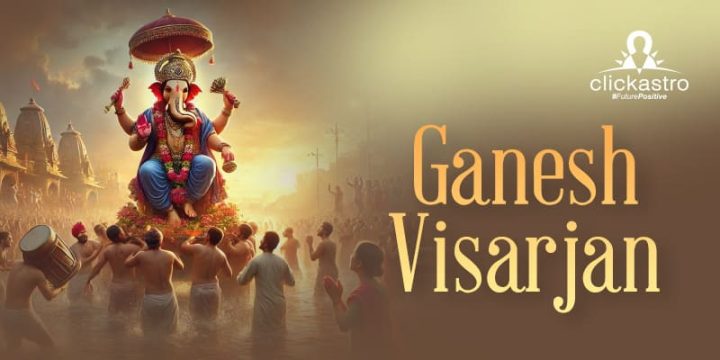Contents[hide]
Introduction
The deeply revered festival of Ganesh Visarjan concludes the joyous 10-day Ganesh Chaturthi celebration, which honours the birth and presence of Lord Ganesha, the remover of obstacles. In 2024, Ganesh Visarjan falls on Tuesday, September 17th, coinciding with Anant Chaturdashi. On this day, devotees bid farewell to Lord Ganesha, immersing his idol in water to symbolize his return to Mount Kailash, the abode of his parents, Lord Shiva and Goddess Parvati. The Visarjan is not merely a ritual; it is a celebration of the divine blessings received during Ganesh Utsav. Families and communities come together and renew their faith, express gratitude, and seek the Lord’s blessings for the year ahead. The festival’s conclusion reminds devotees of life’s impermanence and the cyclical nature of creation, preservation, and dissolution.Ganesh Visarjan Important timings
Ganesh Visarjan 2024 date and day – September 17, Tuesday
- Tithi starts – 16 September at 03:10 p.m
- Tithi ends – 17 September at 11:44 a.m
- Ganesh Puja 2024 Muhurat – 11:08 a.m to 1:33 p.m
- Morning Muhurat (Chara, Labha, Amrita) – 09:11 a.m. to 01:47 p.m
- Afternoon Muhurat (Shubha) – 03:19 p.m to 04:51 p.m
- Evening Muhurat (Labha) – 07:51 p.m to 09:19 p.m
- Night Muhurat (Shubha, Amrita, Chara) – 10:47 p.m to 03:12 a.m, September 18
What is Ganesh Visarjan?
Ganesh Visarjan marks the culmination of the 10-day celebration dedicated to Lord Ganesha. The term “Visarjan” literally means immersion, and it involves the ceremonial submersion of Lord Ganesha’s idol in a natural water body, such as a river, sea, or lake. This act symbolizes the cycle of creation, preservation, and dissolution, which is central to Hindu philosophy.
The idols used for Ganesh Chaturthi are typically crafted from clay, representing the earthly form of the divine. During the festival, these idols are worshipped with great devotion, as Lord Ganesha is believed to reside within them, blessing his devotees and removing obstacles from their lives. The immersion process signifies the return of Ganesha to his cosmic abode after his temporary earthly sojourn. It serves as a reminder of the transient nature of life and the importance of detachment from the material world.
Ganesh Visarjan is a vibrant and emotional event, often accompanied by grand processions, devotional songs, and chants of “Ganpati Bappa Morya, Pudhchya Varshi Laukariya,” meaning “O Lord Ganesha, come again next year.” This ritual not only marks the end of the festival but also reinforces the cyclical nature of existence, reminding devotees of the continuous process of life, death, and rebirth.
Ganesha Mantras: Powerful Chants to Seek Ganesha’s Blessing
Historical Background of Ganesh Visarjan
The tradition of Ganesh Chaturthi and the associated ritual of Ganesh Visarjan dates back several centuries. Originally, the festival was a private affair, celebrated within the confines of individual households, where families would worship clay idols of Lord Ganesha, offering prayers and seeking his blessings. The significance of the festival was enhanced during the reign of the Maratha ruler Shivaji in the 17th century who promoted the worship of Lord Ganesha as a means to foster a sense of unity and cultural pride among his people. The Peshwas, who were prime ministers in the Maratha Empire, continued this tradition in the 18th century, particularly in Pune, where Ganesh Chaturthi became one of the most important festivals. However, it was during the British colonial period in the late 19th century that Ganesh Chaturthi and Visarjan were transformed into large, community-wide celebrations, largely due to the efforts of Bal Gangadhar Tilak, a prominent Indian freedom fighter. Gowri Ganesha Festival: Celebrating the Divine Bond Between Mother and Son In 1893, Tilak recognized the unifying potential of Ganesh Chaturthi in rallying the Indian populace against British rule. He transformed the festival from a private, household event into a public, community-based celebration, known as Sarvajanik Utsav. By encouraging public processions and collective worship, Tilak sought to unite people across different castes and communities, using the festival as a platform to spread nationalist sentiments and strengthen the fight for India’s independence. Tilak’s initiative was a resounding success, and Ganesh Chaturthi quickly became a symbol of cultural and political unity. The public celebration of the festival not only allowed Indians to reclaim their cultural identity under colonial rule but also fostered communal harmony and social cohesion, principles that continue to be at the heart of Ganesh Chaturthi and Visarjan celebrations to this day.Significance of Ganesh Visarjan
Ganesh Visarjan is the concluding ritual of Ganesh Chaturthi. It serves as a powerful reminder of the transient nature of life and the inevitability of change. The Visarjan ritual encapsulates the essence of the philosophy of creation and dissolution, reminding us that all beginnings must eventually come to an end. By immersing the idol of Lord Ganesha in a water body, devotees symbolically acknowledge the impermanence of life, embracing the cycle of birth, life, and death with grace and acceptance. The act of Visarjan also represents the journey from the material (Aakar) to the formless (Nirakaar), highlighting the cyclical nature of existence. Lord Ganesha’s departure from the earthly realm back to Mount Kailash, where he reunites with his divine parents, Lord Shiva and Goddess Parvati, signifies the end of his temporary stay among his devotees. This return to his divine abode is a reminder that while his physical presence may leave, his blessings and teachings remain eternal. Furthermore, Ganesh Visarjan reflects an inherent environmental consciousness embedded in Indian rituals. Traditionally, the idols are made from natural clay, which, upon immersion, dissolves into the water, returning to nature and completing the life cycle. This practice underscores the importance of living in harmony with the environment, as it emphasizes the sustainable use of natural resources and the need to minimize ecological footprints.Ganesh Visarjan Rituals: Step-by-Step Guide
Performing Ganesh Visarjan at home involves several rituals that are both a farewell to the deity and a celebration of his presence. Here is a detailed guide on how to perform the Visarjan Vidhi at home:- Morning Aarti: Begin the day with aarti, a traditional Hindu worship ceremony, with your family and friends. Sing devotional songs like “Sukh Karta Dukh Harta” and “Jai Ganesh Deva” to honour Lord Ganesha.
- Offerings to the Lord: Light diyas (oil lamps) and incense sticks. Offer flowers, fragrant oils, and home-cooked sweets like Modak, a favourite of Lord Ganesha.
- Preparation for Visarjan: As the auspicious time (Muhurat) for Visarjan approaches, gather your family around the puja altar. Before lifting the idol, gently move it towards yourself, signifying the end of Lord Ganesha’s stay in your home.
- Thanksgiving: Offer prayers of gratitude to Lord Ganesha for blessing your home and removing obstacles. This moment is crucial as it reinforces the bond between the devotee and the deity.
- Offer Akshata and Curd: Sprinkle Akshata (a mixture of raw rice and turmeric) over the idol and place curd in Ganesha’s hands as a symbol of prosperity and good luck.
- Prepare for the Journey: Place a dry coconut, jaggery, and five grains in a red cloth near the idol. This symbolic meal is believed to sustain Lord Ganesha during his journey back to Mount Kailash.
- Final Tour of the House: Before leaving for the Visarjan, carry the idol around your home, blessing each room with the divine presence.
- Procession and Immersion: As you step out of your home, another person should hold a coconut, circle it three times over the idol’s head, and then break it. This coconut is later immersed along with the idol. At the Visarjan site, perform a final aarti, remove the decorations from the idol, and immerse it in the water.
The Story Behind Ganesh Visarjan
According to legend, Lord Ganesha was created by his mother, Goddess Parvati, from clay. She moulded him from the earth to stand as a guardian while she bathed, and upon his creation, Ganesha was endowed with life, becoming her devoted son. This creation from clay is a crucial element in understanding the significance of the Visarjan ritual. Just as Ganesha was brought to life from clay, his idol, often made of the same material, is immersed back into the water at the end of the festival. This act symbolizes the return of Ganesha to his celestial abode, underscoring the belief in the cyclical nature of life and the idea that all forms eventually dissolve into the formless. As Ganesha is immersed, devotees chant prayers and sing praises, reaffirming their faith that while his physical form may leave, his spiritual presence and blessings remain. The immersion is not an end, but a promise of renewal, as devotees eagerly await Ganesha’s return the following year, keeping the cycle of devotion and celebration alive.Celebration Across India
Ganesh Visarjan is celebrated with great fervour across India, particularly in states like Maharashtra, Rajasthan, Gujarat, Goa, Karnataka, Andhra Pradesh, and Telangana. The streets come alive with processions filled with music, dance, and chants of “Ganpati Bappa Morya, Pudhchya Varshi Laukariya Ya!” (O Lord Ganesha, come again next year). In cities like Mumbai, Pune, and Hyderabad, massive processions accompany the Visarjan, with thousands of devotees following the idol to the immersion site. These processions are a mix of celebration and solemnity, as devotees bid farewell to the beloved deity with a promise to welcome him again the next year.Ganesh Visarjan 2024: A Day-by-Day Celebration
The 10-day Ganesh Chaturthi festival is marked by various rituals and celebrations leading up to the Visarjan:- Day 1: Installation of the Ganesha idol and prayers to welcome the deity.
- Day 2: The main day of the festival, filled with grand celebrations.
- Day 3-9: Daily prayers, aartis, and offerings are made to Lord Ganesha, with special rituals like the Shhodashopachara Pooja on the fifth day.
- Day 10: The final day, known as Vijayadashami, concludes with the Visarjan procession and immersion.







